
current / archive / issues / faq / RSS feed / twitter /
Blog Archive: January 2019
The End Of The BeginningAs mentioned last time, we've now reached something of a milestone in this blog. Up until now everything discussed has been under Stan Lee's stewardship as Editor-In-Chief, whereas what comes next is a chaotic few years during which five different people fill the role, before Jim Shooter comes on board and changes everything around again.
In my PhD thesis (which is the driving force behind this very blog) I go into quite a lot of detail about why this changeover matters. The general idea is that it marks a shift between what I call the "creation" phase of The Marvel Age, during which most of what we understand as "Marvel comics" is created by a small group of, largely, middle-aged men, to a "chaos" phase during which a new generation of, for the most part, much younger men take over. Its a changing of viewpoint too, from a group who learned their trade during the so-called Golden Age of comics, to a very different group who emerged from comics fandom, who take the very idea of superhero comics a lot more seriously.
That's the theory anyway - whether it actually has any effect on the comics is something we'll find out over the next several months. In the meantime though I think it's worth pausing to look at where we are so far. The blog began just over a year ago with a look at Doctor Doom's first appearance as baddy-of-the-month, but he very quickly developed into something much more, with the key change being his origin story in Fantastic Four Annual #2, which saw him develop as more of an anti-hero, with his own complex motivations and, usually, the sympathy of the audience.
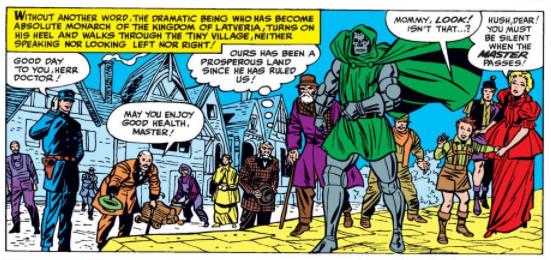 The key signifiers of Doom's history and appearance were pretty much set in stone then, to the extent that he could be used almost exclusively in 'Not Brand Echh' as a figure of fun, before returning to the main Marvel universe with his reputation and character intact.
The key signifiers of Doom's history and appearance were pretty much set in stone then, to the extent that he could be used almost exclusively in 'Not Brand Echh' as a figure of fun, before returning to the main Marvel universe with his reputation and character intact.
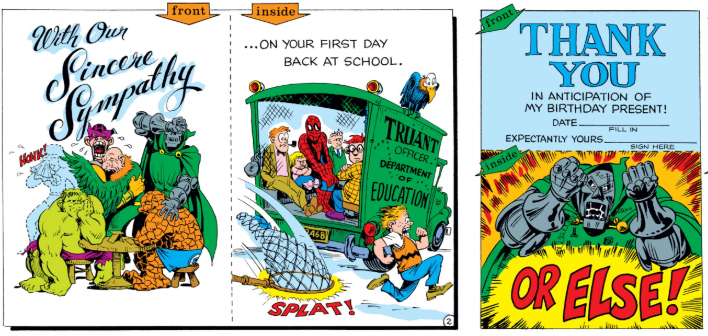 Doom's appearance and origin were so set in stone that they've remained more or less the same until the present day, but his character continued to develop. Stan Lee gradually steered him towards becoming a semi-satire on East European dictators, becoming more outright villainous, and more ready to believe his own publicity.
Doom's appearance and origin were so set in stone that they've remained more or less the same until the present day, but his character continued to develop. Stan Lee gradually steered him towards becoming a semi-satire on East European dictators, becoming more outright villainous, and more ready to believe his own publicity.
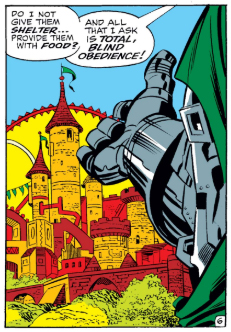 However, whenother writers such as Roy Thomas and Gerry Conway started to use Doom they moved him back towards the tragic anti-hero, acting with his own idea of honour and doing what he believed had to be done to the good of all (which admittedly tended to involve him ruling the world). These two versions of the character existed side by side for some time, with Stan Lee's version becoming more evil while others brought in characters like Valeria and Igor to shed light on his personality.
However, whenother writers such as Roy Thomas and Gerry Conway started to use Doom they moved him back towards the tragic anti-hero, acting with his own idea of honour and doing what he believed had to be done to the good of all (which admittedly tended to involve him ruling the world). These two versions of the character existed side by side for some time, with Stan Lee's version becoming more evil while others brought in characters like Valeria and Igor to shed light on his personality.
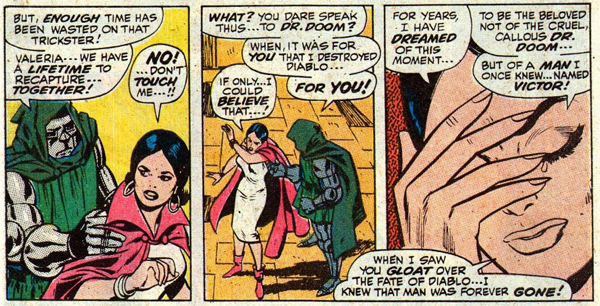 Archie Goodwin seemed to recognise this during Doom's final appearance in The Fantastic Four during this period, having Sue Richards accuse Doom of forgetting his honourable roots.
Archie Goodwin seemed to recognise this during Doom's final appearance in The Fantastic Four during this period, having Sue Richards accuse Doom of forgetting his honourable roots.
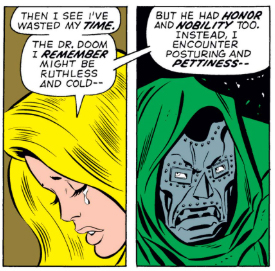 And of course, throughout this time Doom ventured out into other media, appearing wherever the Fantastic Four did and in other places beside. It seems that he was such a well-defined, portable character that he was the first choice for use as a villain not just in comics but elsewhere too.
And of course, throughout this time Doom ventured out into other media, appearing wherever the Fantastic Four did and in other places beside. It seems that he was such a well-defined, portable character that he was the first choice for use as a villain not just in comics but elsewhere too.
The next six years will see Doom travel even further across the Marvel Universe, appearing in most of their regular titles as well as on albums, radio, television, and even meeting the band Kiss. I'm really looking forward to seeing what happens, and hope you'll be along for the ride with me!
posted 29/1/2019 by MJ Hibbett
(click here for permanent link)
(0) comments
The Return Of The Monster
The most fleeting of Doom appearances in this issue, as The Thing and Human Torch struggle to work out whether they've met that month's baddy before.
It's a problem I'm surprised they don't have more often - they do meet a lot of monsters - and they attempt to solve it by using a projector screen like a science-fiction 1970s version of Tindr, swiping through to find the monster they're looking for.
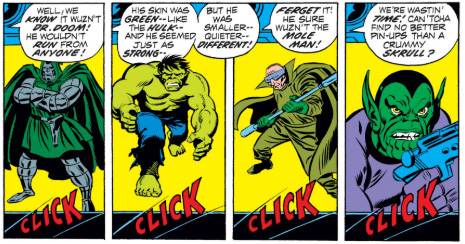 I have to agree with The Thing's opinion here - surely they can at least filter the results somehow - but they do eventually work out who it is they're facing, and Doctor Doom plays no real part in the story whatsoever. This is right at the end of Stan Lee's run on the title, and isn't what you'd call a classic story, so maybe this is him remining readers of some of the great characters he's co-created in the past, before his final story in the next issue.
I have to agree with The Thing's opinion here - surely they can at least filter the results somehow - but they do eventually work out who it is they're facing, and Doctor Doom plays no real part in the story whatsoever. This is right at the end of Stan Lee's run on the title, and isn't what you'd call a classic story, so maybe this is him remining readers of some of the great characters he's co-created in the past, before his final story in the next issue.
Talking of which, this is a low-key milestone in Doom's history, as it's the last time he'll appear in the first stage of The Marvel Age - what I'm calling the "Creation" period. In a couple of months' time Stan Lee will have stepped down as Editor-In-Chief and Roy Thomas will (briefly) take over, kicking off a tumultuous few years that I'm calling the "Chaos" period, before Jim Shooter rolls in at the end of the decade and changes things all over again. For that reason, the next blog will be a very special, no-specific-issue, edition, when we'll look at how far we've come since Doom first appeared. See you then!
posted 25/1/2019 by MJ Hibbett
(click here for permanent link)
(0) comments
The Dreamstone
This third and final part of the Namor/Doom team-up picks up exactly where the last one ended, with Namor being attacjed by Modok's army of androids. It turns out not to have been much of a cliffhanger, however, as he beats them easily, only falling when Modok steps into the battle and zaps him with a deadly Mindblast. Why he couldn't have done this to start with I don't know - let the world tremble should I ever become a super-villain, for LO! I would be much better organised!
When Doom wakes up Modok tells him he's captured Namor, and summons him for a meeting to discuss terms. Doom goes and, along the way, indulges in some more self-reflection, wondering why it is that he is acting to save Namor.
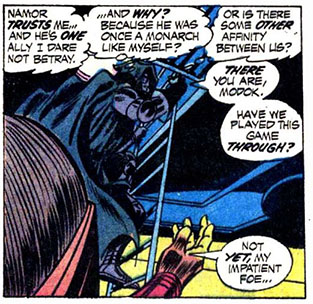 Could they be... friends?!? When Modok mocks him for coming, Doom replies that he has done so because he is a man, "and men have feelings... and yes, have loyalty!" Again, this is most unlike the Doom of old but very much in tune with the tortured character that Conway is now writing him as. Previously Doom would have denied any such perceived weakness and claimed he was only acting out of devious self-interest, but here he's proud of his emotions.
Could they be... friends?!? When Modok mocks him for coming, Doom replies that he has done so because he is a man, "and men have feelings... and yes, have loyalty!" Again, this is most unlike the Doom of old but very much in tune with the tortured character that Conway is now writing him as. Previously Doom would have denied any such perceived weakness and claimed he was only acting out of devious self-interest, but here he's proud of his emotions.
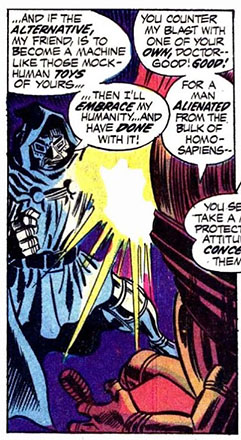 There's another big fight, which expands out to Doom's ship, where his delightfully normally-named henchmen wonder what's happened to that twit Kenner while they launch an attack on the AIM base. Meanwhile Namor manages to trick some androids into giving him a tube of water, which he splashes all over himself to revive his superpowers. I must admit I've always found Namor to be a bit of a rubbish superhero - his secret weakness is getting dehydrated, but he can be easily revived by a tap - but it does lead to a rather brilliant Gene Colan illustration of him bursting out of his chains.
There's another big fight, which expands out to Doom's ship, where his delightfully normally-named henchmen wonder what's happened to that twit Kenner while they launch an attack on the AIM base. Meanwhile Namor manages to trick some androids into giving him a tube of water, which he splashes all over himself to revive his superpowers. I must admit I've always found Namor to be a bit of a rubbish superhero - his secret weakness is getting dehydrated, but he can be easily revived by a tap - but it does lead to a rather brilliant Gene Colan illustration of him bursting out of his chains.
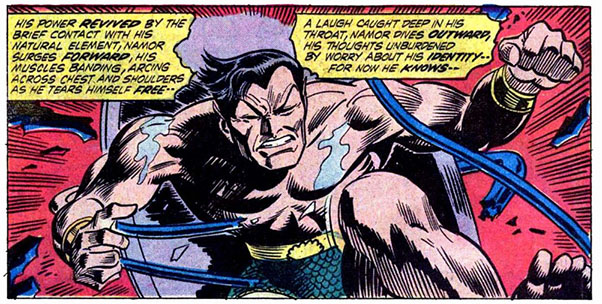 Namor heads off to a radioactive chamber where he discovers the Cosmic Cube in a handily labelled container, not unlike the sort of thing you'd see on the Batman TV show.
Namor heads off to a radioactive chamber where he discovers the Cosmic Cube in a handily labelled container, not unlike the sort of thing you'd see on the Batman TV show.
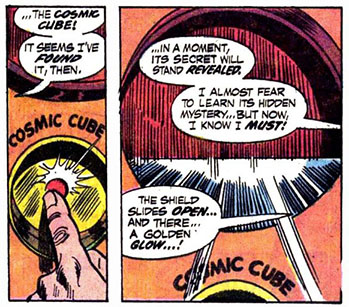 The container opens and Namor sees something horrific, but we don't find out what it is because we briefly flip over to catch up with Cindy Jones. She's decided to try and escape, and is doing so by... er... flashing some leg.
The container opens and Namor sees something horrific, but we don't find out what it is because we briefly flip over to catch up with Cindy Jones. She's decided to try and escape, and is doing so by... er... flashing some leg.
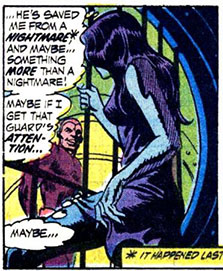 The guard seems utterly delighted by this turn of events, which is a bit odd bearing in mind that the last guard who took a lewd interest in Cindy was instantly executed by his employer. Perhaps he feels safe because Doom is out of the office, in Modok's control room getting into a proper Big Supervillain Fight, during which he proudly talks about his root to power as a demonstration of his unwillingness to give in.
The guard seems utterly delighted by this turn of events, which is a bit odd bearing in mind that the last guard who took a lewd interest in Cindy was instantly executed by his employer. Perhaps he feels safe because Doom is out of the office, in Modok's control room getting into a proper Big Supervillain Fight, during which he proudly talks about his root to power as a demonstration of his unwillingness to give in.
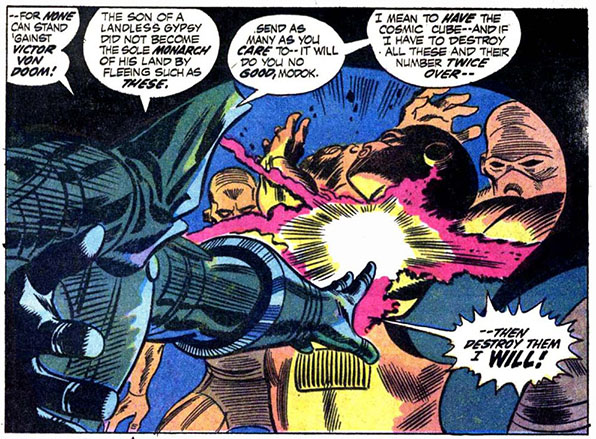 This is yet another example of Conway writing Doom differently to recent portrayals, harking back to the idea that he's a working class revolutionary, as used so effectively in his earlier appearances. Doom beats Modok only to discover that it was a robot all along, with Modok watching via TV screen. Using a robot while watching the action on a TV set? Modok is totally ripping off Doctor Doom, as well as being unforgiveably snobbish!
This is yet another example of Conway writing Doom differently to recent portrayals, harking back to the idea that he's a working class revolutionary, as used so effectively in his earlier appearances. Doom beats Modok only to discover that it was a robot all along, with Modok watching via TV screen. Using a robot while watching the action on a TV set? Modok is totally ripping off Doctor Doom, as well as being unforgiveably snobbish!
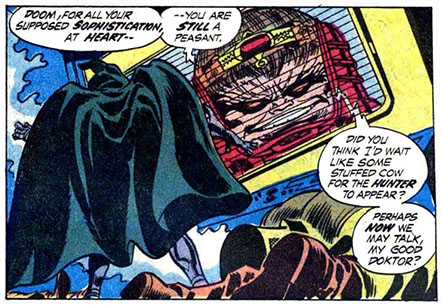 Doom ignores this and goes in search of the cube, along the way revealing his true purpose - he wants to use the Cosmic Cube to cure his facial disfigurement, so that he can be the man he once was and be at peace!
Doom ignores this and goes in search of the cube, along the way revealing his true purpose - he wants to use the Cosmic Cube to cure his facial disfigurement, so that he can be the man he once was and be at peace!
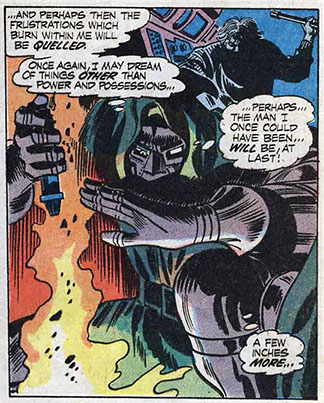 I keep saying that this is a very different version of Doom from what we've seen lately, because it is. This is a Doom back to the nuanced, sympathetic, properly motivated character of the origin and mid-sixties, rather than the deranged dictator of more recent times, and I have to say I prefer it. Unfortunately though, before he can get the cube, the long-running sub-plot about the minion called Kenner comes back, as he is discovered to be an assassin placed on the ship in order to get closer to the Sub-Mariner and kill him. He surprises Doom and knocks him unconscious, but we don't find out who has sent him here, or how he knew that Doom and Namor would be teaming up, as he immediately becomes entranced by the Cosmic Cube and destroyed by it.
I keep saying that this is a very different version of Doom from what we've seen lately, because it is. This is a Doom back to the nuanced, sympathetic, properly motivated character of the origin and mid-sixties, rather than the deranged dictator of more recent times, and I have to say I prefer it. Unfortunately though, before he can get the cube, the long-running sub-plot about the minion called Kenner comes back, as he is discovered to be an assassin placed on the ship in order to get closer to the Sub-Mariner and kill him. He surprises Doom and knocks him unconscious, but we don't find out who has sent him here, or how he knew that Doom and Namor would be teaming up, as he immediately becomes entranced by the Cosmic Cube and destroyed by it.
Doom is left beside the glowing cube, moments away from destruction, but is rescued by Cindy - she was let out of her cage by a randy guard who gets a well-deserved bonk on the head with a spanner for his troubles. She drags Doom away from the radioactive cube, only for him to try to fight his way back towards it when he wakes up. It's only when Namor turns up and tell him it's a bad idea that Doom is persuaded to leave it be, and even then he has to pause a moment to think about what might have been.
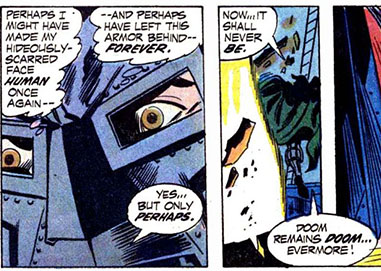 They escape into Doom's ship just in time to fly away as the cube explodes, taking the whole base with it and, presumably, irradiating the ocean for miles around. We next see the trio in New Orleans, saying goodbye. Doom tells Namor what he knows about the plot by Kenner to kill him, and then disappears into the mist, saying "you've gained a friend."
They escape into Doom's ship just in time to fly away as the cube explodes, taking the whole base with it and, presumably, irradiating the ocean for miles around. We next see the trio in New Orleans, saying goodbye. Doom tells Namor what he knows about the plot by Kenner to kill him, and then disappears into the mist, saying "you've gained a friend."
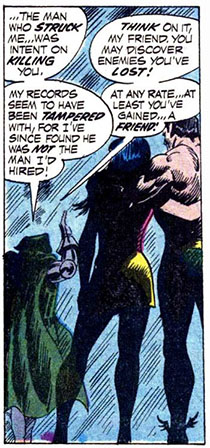 And there the issue, and the story, comes to an end. As so often happens, Doom has more or less taken over another character's book and been by far the most interesting part of it, especially now that Gerry Conway is trying to return him to his tortured roots. It'll be interesting to see whether this characterisation sticks!
And there the issue, and the story, comes to an end. As so often happens, Doom has more or less taken over another character's book and been by far the most interesting part of it, especially now that Gerry Conway is trying to return him to his tortured roots. It'll be interesting to see whether this characterisation sticks!
posted 23/1/2019 by MJ Hibbett
(click here for permanent link)
(0) comments
Twlight Of The Hunted!
This story starts with Doom and Namor stepping out in New Orleans near the site of the supposedly abandoned AIM base they were heading for last time, and almost immediately getting into an argument. Doom says that Namor's friend Cindy Jones should not accompany them, while Namor insists she should. When Cindy herself suggests she could head into New Orleans herself the Sub-Mariner ignores her and flies off in a huff, zooming away out of earshot before Doom has a chance to talk about it it.
A willingness to negotiate and think of others is unusual for Doom, to the extent that one of his henchmen, Franklin, remarks upon it as he's sent off to watch over Namor.
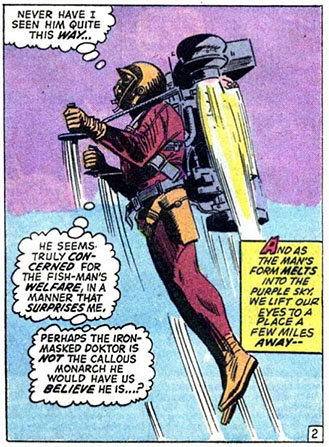 There'll be more of this this sort of thing throughout the story, as well as more henchmen with names that sound like they work for a bank. Before that, however, we follow Namor to New Orleans, where he has decided to return Cindy for safekeeping after all. Franklin watches as they enter Cindy's old home, which appears to be a commune ruled over by a startlingly realistic pusher called 'Brother Johnny'.
There'll be more of this this sort of thing throughout the story, as well as more henchmen with names that sound like they work for a bank. Before that, however, we follow Namor to New Orleans, where he has decided to return Cindy for safekeeping after all. Franklin watches as they enter Cindy's old home, which appears to be a commune ruled over by a startlingly realistic pusher called 'Brother Johnny'.
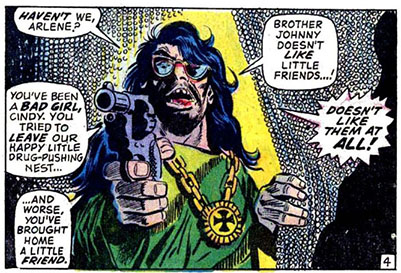 There's a big fight, during which Franklin kidnaps/rescues Cindy and Namor is knocked unconscious, only to be awoken by police and thrown into another fight. At this point Doctor Doom appears to rescue his friend, much to the relief of the local cops who suggest that he takes Namor away to save them some paperwork.
There's a big fight, during which Franklin kidnaps/rescues Cindy and Namor is knocked unconscious, only to be awoken by police and thrown into another fight. At this point Doctor Doom appears to rescue his friend, much to the relief of the local cops who suggest that he takes Namor away to save them some paperwork.
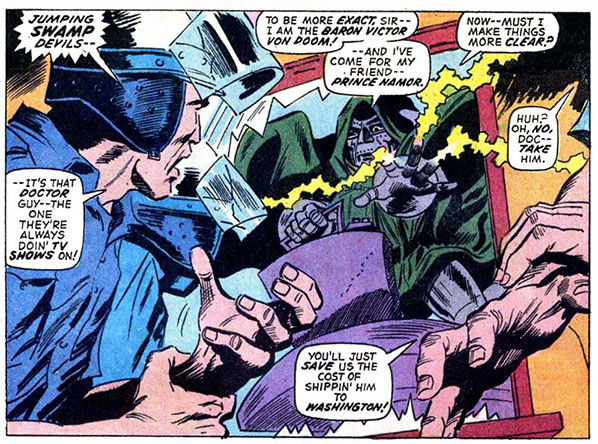 Doom tells Namor that Cindy is his prisoner, and that he must do exactly as he is told to secure her safety. Namor agrees and is soon being dropped off closer to the base, while Doom indulges in some self-reflection.
Doom tells Namor that Cindy is his prisoner, and that he must do exactly as he is told to secure her safety. Namor agrees and is soon being dropped off closer to the base, while Doom indulges in some self-reflection.
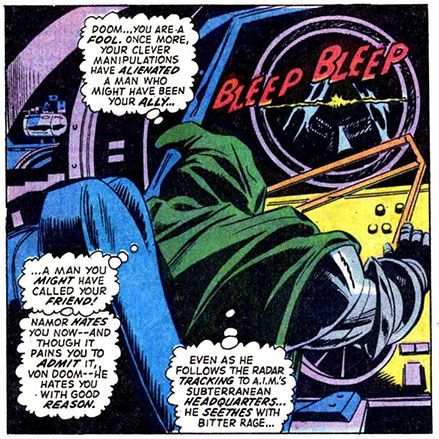 This is distinctly unlike the Doom we have come to know, although not entirely out of character. We very rarely get to hear Doom's thoughts, so it's quite possible that, for instance, he's been remonstrating with himself on a regular basis while simultaneously acting like, well, Doctor Doom. Here, for instance, in the recent Incredible Hulk #144, could he really be thinking "I've messed this up so badly with Valeria, please don't leave me alone so I have to talk to her"?
This is distinctly unlike the Doom we have come to know, although not entirely out of character. We very rarely get to hear Doom's thoughts, so it's quite possible that, for instance, he's been remonstrating with himself on a regular basis while simultaneously acting like, well, Doctor Doom. Here, for instance, in the recent Incredible Hulk #144, could he really be thinking "I've messed this up so badly with Valeria, please don't leave me alone so I have to talk to her"?
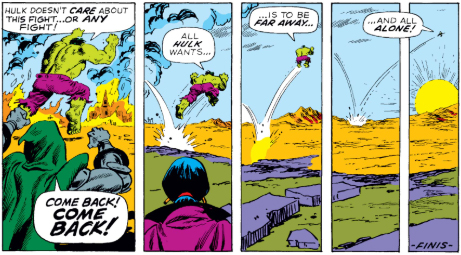 Or maybe in the classic The Power And The Pride, rather than being supremely arrogant, is Doom really desperately hoping that people will like him?
Or maybe in the classic The Power And The Pride, rather than being supremely arrogant, is Doom really desperately hoping that people will like him?
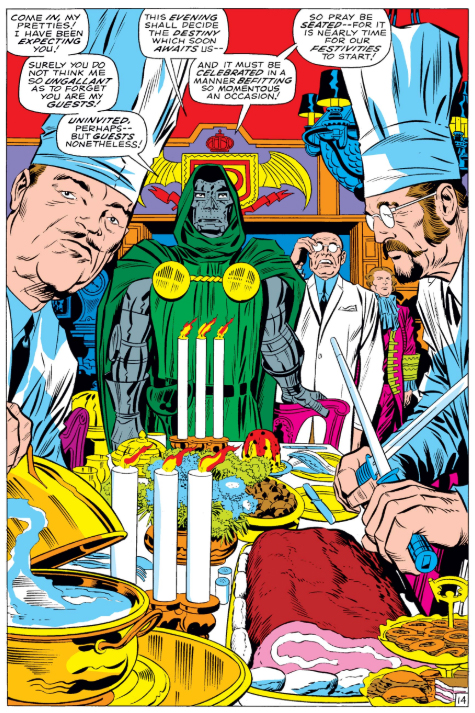 All right, maybe not, but it's an interesting way to look at the character, possibly reflecting the inner workings of Gerry Conwway who is, after all, only 19 years old and so (if he's anything like most teenagers I've known or indeed been) he's probably plagued with very similar self-doubt.
All right, maybe not, but it's an interesting way to look at the character, possibly reflecting the inner workings of Gerry Conwway who is, after all, only 19 years old and so (if he's anything like most teenagers I've known or indeed been) he's probably plagued with very similar self-doubt.
Back in the comic, Doom's introspection is cut short here by a signal from his bank of machinery which jolts him back to his normal self, although we only see his spoken words, so beneath the bluster he may still be riven with doubt.
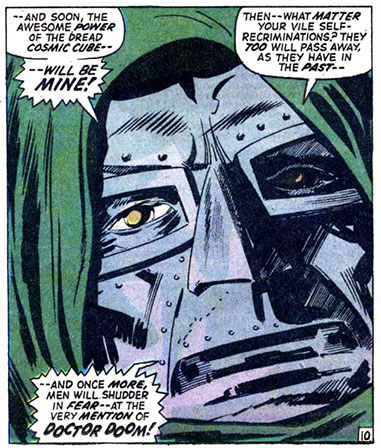 The ship dives into the sea, becoming a submarine, and we see a bunch of henchmen busy at work. One of them asks his chum Orson if he's seen another colleague called Kenner lately, who was sent off to get some coffee and never came back. It's all very office-like, and entirely unlike the East European thugs we've become used to seeing in Doom's employ - a fact that will pay off a bit later.
The ship dives into the sea, becoming a submarine, and we see a bunch of henchmen busy at work. One of them asks his chum Orson if he's seen another colleague called Kenner lately, who was sent off to get some coffee and never came back. It's all very office-like, and entirely unlike the East European thugs we've become used to seeing in Doom's employ - a fact that will pay off a bit later.
Meanwhile Namor is swimming towards the base, fighting automatic defences on the way. Similar defences shoot at Doom's ship, but despite this Doom remains sure that Modok is dead. There's then a brief interlude during which Modok watches his enemies approach and reminisces about how he survived - he had a secret underground railway and robot army ready, just in case he was ever caught in a collapsing building, which is only sensible if you happen to be a supervillain living in the Marvel universe - before we return to Doom's ship, where Cindy Jones is being visited by the office creep.
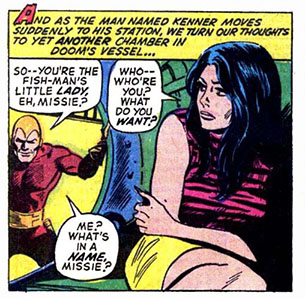 Luckily for Cindy, but less so for Wilson (another very American name, along with Orson, Kenner and Franklin), his boss Doctor Doom turns up and flat out kills him. Cindy, oddly, tries to excuse Orson's behaviour, saying "he was only.." before Doom cuts her off, saying he has no time whatsoever for that sort of behaviour. It's another example of Doom being shown in a good light, clamping down on sexual harrassment in the workplace, even if some would argue that his methods are perhaps a little harsh. The message is clear though: even world-conquering dictators disapprove of sexual harassment.
Luckily for Cindy, but less so for Wilson (another very American name, along with Orson, Kenner and Franklin), his boss Doctor Doom turns up and flat out kills him. Cindy, oddly, tries to excuse Orson's behaviour, saying "he was only.." before Doom cuts her off, saying he has no time whatsoever for that sort of behaviour. It's another example of Doom being shown in a good light, clamping down on sexual harrassment in the workplace, even if some would argue that his methods are perhaps a little harsh. The message is clear though: even world-conquering dictators disapprove of sexual harassment.
The issue ends with Namor fighting his way into the base, only to discover Modok waiting for him (as we all knew he was, so again the big surprise splash isn't much of a surprise). A bigger surprise, perhaps, is the revelation that the "weapon" Doom had come here to steal is actually... a Cosmic Cube! This is a McGuffin capable of changing reality and giving the user power over reality itself, as well as being utterly meaningless to anyone who hasn't read Marvel comics much. Ending with this reveal as the cliff-hanger demonstrates how much Marvel was relying on its readers having an in-depth knowledge of the storyworld during this period, and hopefully it'll work here in the 21st Century to bring you back next time to see how the story concludes!
posted 18/1/2019 by MJ Hibbett
(click here for permanent link)
(0) comments
Doomsmasque
This issue features the 'dream team' (according to me anyway) of Gerry Conway and Gene Colan, with a story titled 'Doomsmasque' as opposed to the 'Deathmasque' promised at the end of Astonishing Tales #8. Clearly Gerry Conway was quite pleased with the word 'masque', even going so far to define it for the readers on the splash page!
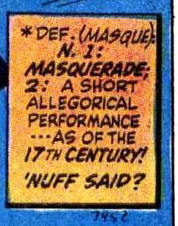 I didn't realise before, but Conway was only around 19 years old when he wrote that (rather brilliant) story, and by the time this issue rolled around he was working regularly for Marvel across all their titles as one of the wave of new creators who came in during this period. His work here is very much in the Stan Lee style, though concentrating a lot more on the florid descriptions and 'Shakespearean' dialogue than humour for the most part.
I didn't realise before, but Conway was only around 19 years old when he wrote that (rather brilliant) story, and by the time this issue rolled around he was working regularly for Marvel across all their titles as one of the wave of new creators who came in during this period. His work here is very much in the Stan Lee style, though concentrating a lot more on the florid descriptions and 'Shakespearean' dialogue than humour for the most part.
The story starts off with Prince Namor on a train, having lost his memory after the shock of seeing his father die in his arms in the previous issue. After fighting off some hoboes he jumps off the train in Chicago and is almost shot by a policeman, only saved by a cloaked figure dissolving the cop's gun before he can fire. Whoever could it be?
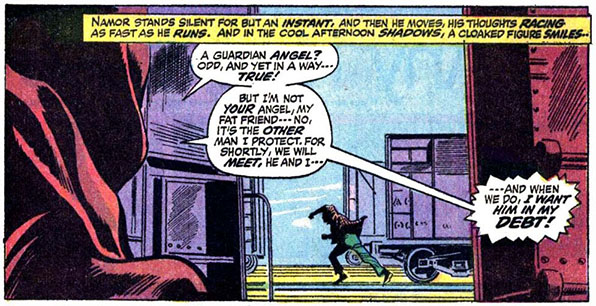 Namor then meets a girl, Cindy Jones, who takes him into her house. They're sitting having a chat and a mildly flirty coffee when there's a knock at the door. Namor answers it to find -
Namor then meets a girl, Cindy Jones, who takes him into her house. They're sitting having a chat and a mildly flirty coffee when there's a knock at the door. Namor answers it to find -
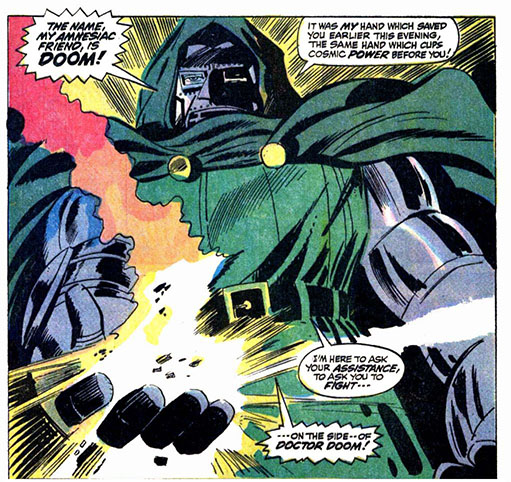 Doctor Doom! The surprise is a little diminished by the fact that he was on the cover and in the story's title, but still, it jogs Namor's memory, reminding him of all the other times they have met.
Doctor Doom! The surprise is a little diminished by the fact that he was on the cover and in the story's title, but still, it jogs Namor's memory, reminding him of all the other times they have met.
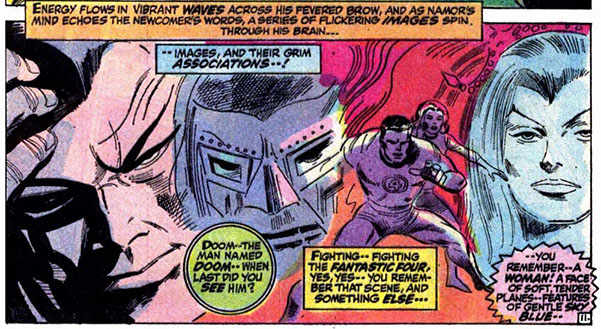 This also reminds Namor of the recent death of his bride Dorma, sending him into a furious rage. He attacks Doom who fights back, but only gently, preferring not to hurt Namor as he needs him alive for whatever plan it is he's working on this time. This is a much calmer, considered Doom than we've seen in the most recent Stan Lee stories, who flies into a rage at the merest perceived slight, as is especially apprent when he decides to allow Namor to throw him around a bit to work off some anger, through the wall into the next door apartment.
This also reminds Namor of the recent death of his bride Dorma, sending him into a furious rage. He attacks Doom who fights back, but only gently, preferring not to hurt Namor as he needs him alive for whatever plan it is he's working on this time. This is a much calmer, considered Doom than we've seen in the most recent Stan Lee stories, who flies into a rage at the merest perceived slight, as is especially apprent when he decides to allow Namor to throw him around a bit to work off some anger, through the wall into the next door apartment.
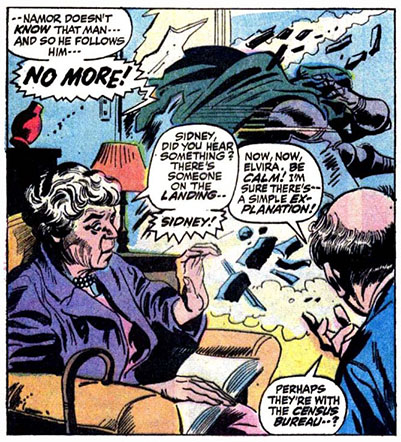 This is a lovely sequence very much in the early Marvel tradition of mixing the everyday in with superhero antics, featuring Doom setting fire to the elderly couple's sofa and then quickly putting it out again to prevent any further damage (apart from the wall, obviously, and soon the window). Again, we see Doom expressing consideration for others, even if he does insist that it's all to preserve his reputation rather than any deeper feeling.
This is a lovely sequence very much in the early Marvel tradition of mixing the everyday in with superhero antics, featuring Doom setting fire to the elderly couple's sofa and then quickly putting it out again to prevent any further damage (apart from the wall, obviously, and soon the window). Again, we see Doom expressing consideration for others, even if he does insist that it's all to preserve his reputation rather than any deeper feeling.
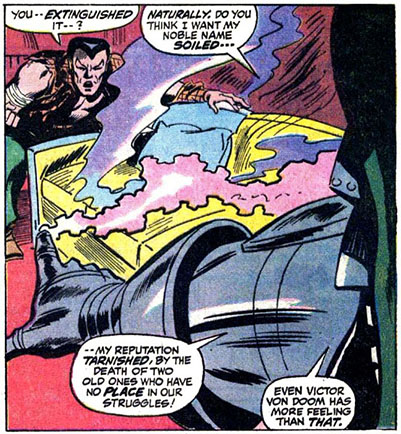 Namor disagrees with even this level of professed feeling, saying "you but masquerade as a man," using a word which, thanks to the definition at the start of the issue, we all know the meaning of.
Namor disagrees with even this level of professed feeling, saying "you but masquerade as a man," using a word which, thanks to the definition at the start of the issue, we all know the meaning of.
They fall through the window and out onto the street for more fighting, at which point Cindy Jones appears and begs them to stop. Doom invites Namor back to the Latverian Embassy - although surely, with Chicago not being the capital, this should be the Latverian consulate - and invites him to team-up again by telling a heavily doctored version of their history together which carefully avoids tricky subjects like betrayals and double-crosses.
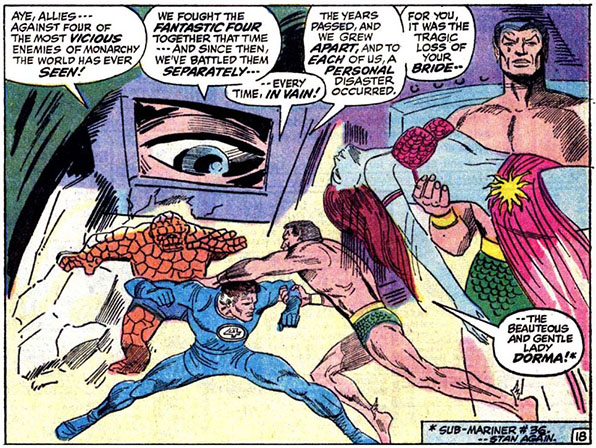 Namor agrees and the pair of them, along with Cindy, hop into Doom's jet and head off for an abandoned AIM (Advanced Idea Mechanics) base, where Doom hopes to find a "most fantastic weapon". After avoiding some automatic defences, Doom ponders the fact that he might not be attempting this at all if he wasn't convinced that Modok, the leader of AIM, was dead.
Namor agrees and the pair of them, along with Cindy, hop into Doom's jet and head off for an abandoned AIM (Advanced Idea Mechanics) base, where Doom hopes to find a "most fantastic weapon". After avoiding some automatic defences, Doom ponders the fact that he might not be attempting this at all if he wasn't convinced that Modok, the leader of AIM, was dead.
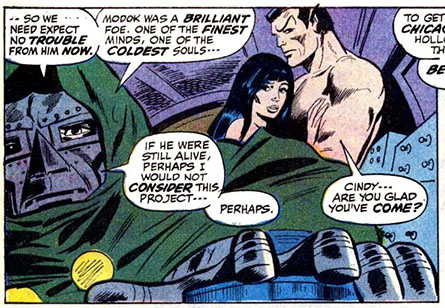 This being comics we instantly know that Modok must therefore definitely be alive, and the issue concludes with the giant-headed baddy laughing at Doom's mistake and looking forward to fighting him again. But how did Doom get it so wrong? I am comvinced that we will not find out next time!
This being comics we instantly know that Modok must therefore definitely be alive, and the issue concludes with the giant-headed baddy laughing at Doom's mistake and looking forward to fighting him again. But how did Doom get it so wrong? I am comvinced that we will not find out next time!
posted 16/1/2019 by MJ Hibbett
(click here for permanent link)
(0) comments
Back To The Sixties
We start the new year with a flashback to the sixties, and an example of the big problems that crop up trying to use databases created by fans in this sort of research.
According to my database, which was compiled from several fan-built databases, the next issue to look at in the run of Doom's appearances is Marvel Superheroes #31. However, a quick look at this issue shows that it's in fact a reprint of several older stories, including a Stan Lee/Steve Ditko 'Tales To Astonish', an Iron Man from 1967 and, most relevant to us here, Daredevil #19 from 1965.
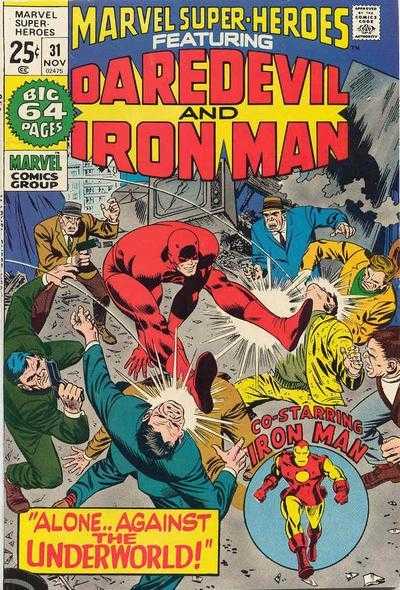 As I say, I used several databases as sources for my 'corpus' of comics, but not a single one of them mentioned Daredevil #19 as having a Doom appearance. Admittedly that's probably because it's barely an appearance at all. Daredevil is on the run from some Hoods (or possibly Goons) and makes his way through a costume store, where he sees some display waxworks in familiar outfits.
As I say, I used several databases as sources for my 'corpus' of comics, but not a single one of them mentioned Daredevil #19 as having a Doom appearance. Admittedly that's probably because it's barely an appearance at all. Daredevil is on the run from some Hoods (or possibly Goons) and makes his way through a costume store, where he sees some display waxworks in familiar outfits.
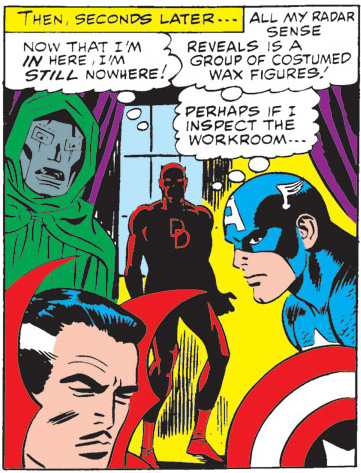 It would be very easy to argue that the original story was not included anywhere because it's just a dummy in a phoney costume and not technically a Doom appearance at all, , but i that case it shouldn't have been included in the listing for the reprint either. The whole thing is a good example of how the lack of strict guidelines about what counts as a 'real' appearance by a character produces multiple discrepancies between databases and indeed within the same databases, and shows why data cleaning (because that's what it is!) is vital for any analysis of them.
It would be very easy to argue that the original story was not included anywhere because it's just a dummy in a phoney costume and not technically a Doom appearance at all, , but i that case it shouldn't have been included in the listing for the reprint either. The whole thing is a good example of how the lack of strict guidelines about what counts as a 'real' appearance by a character produces multiple discrepancies between databases and indeed within the same databases, and shows why data cleaning (because that's what it is!) is vital for any analysis of them.
It's also a shame that I didn't discover this in the right chronological order, as it's an interesting use of Doom, or the appearance of Doom, at an early stage of the Marvel Universe. This was only his third appearance outside of his native series, 'Fantastic Four', and the fact that he's included in the panel without comment, alongside the much more well known Captain America, in a series that he's never been in before, shows how Marvel readers were expected to know what was going on elsewhere. In a way it's a harbinger of his use in 'Not Brand Echh' too.
Still, it gives me a chance to have a bit of a moan about the logistical problems inherent in this process before we get into the main business again, which we'll do next time as Doctor Doom once more meets Namor, The Sub-mariner!
posted 11/1/2019 by MJ Hibbett
(click here for permanent link)
(0) comments